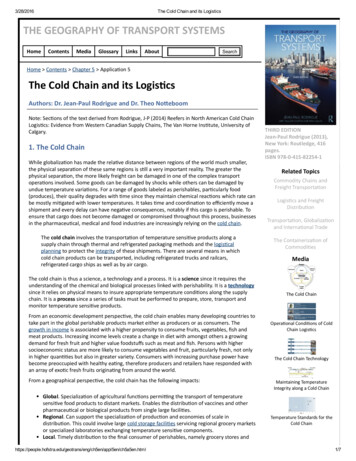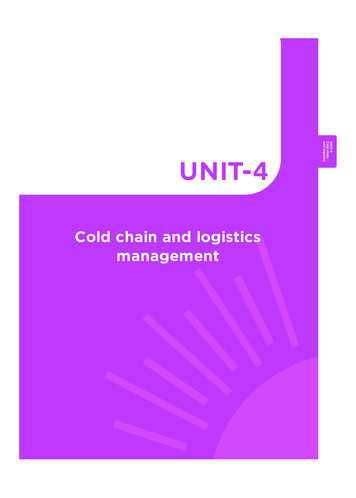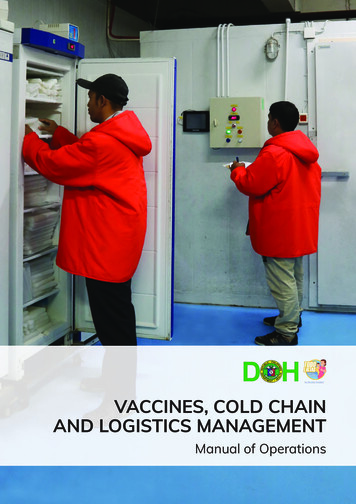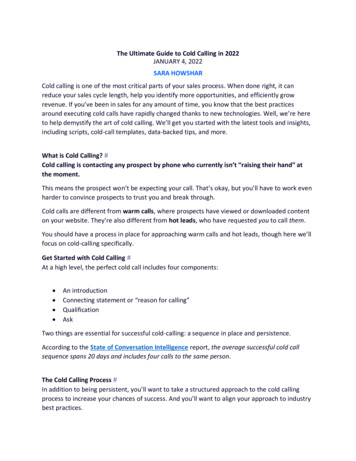
Transcription
3/28/2016The Cold Chain and its LogisticsTHE GEOGRAPHY OF TRANSPORT me Contents Chapter 5 Applica鋙 on 5The Cold Chain and its Logis鋙 csAuthors: Dr. Jean‐Paul Rodrigue and Dr. Theo No태 eboomNote: Sec鋙 ons of the text derived from Rodrigue, J‐P (2014) Reefers in North American Cold ChainLogis鋙 cs: Evidence from Western Canadian Supply Chains, The Van Horne Ins鋙 tute, University ofCalgary.1. The Cold ChainWhile globaliza鋙 on has made the rela鋙 ve distance between regions of the world much smaller,the physical separa鋙 on of these same regions is s鋙 ll a very important reality. The greater thephysical separa鋙 on, the more likely freight can be damaged in one of the complex transportopera鋙 ons involved. Some goods can be damaged by shocks while others can be damaged byundue temperature varia鋙 ons. For a range of goods labeled as perishables, par鋙 cularly food(produces), their quality degrades with 鋙 me since they maintain chemical reac鋙 ons which rate canbe mostly mi鋙 gated with lower temperatures. It takes 鋙 me and coordina鋙 on to efficiently move ashipment and every delay can have nega鋙 ve consequences, notably if this cargo is perishable. Toensure that cargo does not become damaged or compromised throughout this process, businessesin the pharmaceu鋙 cal, medical and food industries are increasingly relying on the cold chain.The cold chain involves the transporta鋙 on of temperature sensi鋙 ve products along asupply chain through thermal and refrigerated packaging methods and the logis鋙 calplanning to protect the integrity of these shipments. There are several means in whichcold chain products can be transported, including refrigerated trucks and railcars,refrigerated cargo ships as well as by air cargo.The cold chain is thus a science, a technology and a process. It is a science since it requires theunderstanding of the chemical and biological processes linked with perishability. It is a technologysince it relies on physical means to insure appropriate temperature condi鋙 ons along the supplychain. It is a process since a series of tasks must be performed to prepare, store, transport andmonitor temperature sensi鋙 ve products.From an economic development perspec鋙 ve, the cold chain enables many developing countries totake part in the global perishable products market either as producers or as consumers. Thegrowth in income is associated with a higher propensity to consume fruits, vegetables, fish andmeat products. Increasing income levels create a change in diet with amongst others a growingdemand for fresh fruit and higher value foodstuffs such as meat and fish. Persons with highersocioeconomic status are more likely to consume vegetables and fruit, par鋙 cularly fresh, not onlyin higher quan鋙 鋙 es but also in greater variety. Consumers with increasing purchase power havebecome preoccupied with healthy ea鋙 ng, therefore producers and retailers have responded withan array of exo鋙 c fresh fruits origina鋙 ng from around the world.From a geographical perspec鋙 ve, the cold chain has the following impacts:Global. Specializa鋙 on of agricultural func鋙 ons permiỠ ng the transport of temperaturesensi鋙 ve food products to distant markets. Enables the distribu鋙 on of vaccines and otherpharmaceu鋙 cal or biological products from single large facili鋙 es.Regional. Can support the specializa鋙 on of produc鋙 on and economies of scale indistribu鋙 on. This could involve large cold storage facili鋙 es servicing regional grocery marketsor specialized laboratories exchanging temperature sensi鋙 ve components.Local. Timely distribu鋙 on to the final consumer of perishables, namely grocery stores ppl5en/ch5a5en.htmlTHIRD EDITIONJean‐Paul Rodrigue (2013),New York: Routledge, 416pages.ISBN 978‐0‐415‐82254‐1Related TopicsCommodity Chains andFreight Transporta鋙 onLogis鋙 cs and FreightDistribu鋙 onTransporta鋙 on, Globaliza鋙 onand Interna鋙 onal TradeThe Containeriza鋙 on ofCommodi鋙 esMediaThe Cold ChainOpera鋙 onal Condi鋙 ons of ColdChain Logis鋙 csThe Cold Chain TechnologyMaintaining TemperatureIntegrity along a Cold ChainTemperature Standards for theCold Chain1/7
3/28/2016The Cold Chain and its Logisticsrestaurants.Some domes鋙 c or transna鋙 onal supply chains may only require one transporta鋙 on mode, butmany 鋙 mes ground shipments are only one link in a combina鋙 on of transport modes. This makesintermodal transfers cri鋙 cal for the cold chain. Intermodal shipments typically use either 20 or 40foot refrigerated containers that are capable of holding up to 26 tons of food. The container makesloading and unloading periods shorter and less suscep鋙 ble to damage both on the container andits cargo. The environments in these containers are controlled electronically by either plugginginto a generator or power source on the ship or truck. The efficiency of cold chain logis鋙 cspermi태 ed the consolida鋙 on of cold storage facili鋙 es.Income per Capita and PerishableShare of Food ImportsAvailability of Fresh Produce bySeason and Region2. Emergence of Cold Chain Logis鋙 csWhile global commodity chains are fairly modern expansions in the transporta鋙 on industry, therefrigerated movement of temperature sensi鋙 ve goods is a prac鋙 ce that dates back to 1797 whenBri鋙 sh fishermen used natural ice to preserve their fish stock piles while at sea. This process wasalso seen in the late 1800s for the movement of food from rural areas to urban consump鋙 onmarkets, namely dairy products. Cold storage was also a key component of food trade betweencolonial powers and their colonies. For example, in the late 1870s and early 1880s, France wasstar鋙 ng to receive large shipments of frozen meat and mu태 on carcasses from South America,while Great Britain imported frozen beef from Australia and pork and other meat from NewZealand. This process was incited by a shortage of meat produc鋙 on in Europe and substan鋙 alsurpluses in developing countries. By 1910, 600,000 tons of frozen meat was being brought intoGreat Britain alone. The first reefer ship for the banana trade was introduced in 1902 by theUnited Food Company. This enabled the banana to move from an exo鋙 c fruit that had a smallmarket because it arrived in markets too ripe, to one of the world's most consumed fruit. Itsimpacts on the reefer industry were monumental.The temperature controlled movement of pharmaceu鋙 cals and medical supplies is a much morerecent ac鋙 vity than the shipping of refrigerated or frozen food. Since the 1950s, logis鋙 cal thirdparty companies began to emerge and ins鋙 tute new methods for successfully transpor鋙 ng theseglobal commodi鋙 es. Before their emergence, cold chain processes were mostly managed in houseby the manufacturer. In the United States, Food and Drug Administra鋙 on restric鋙 ons andaccountability measures over the stability of the cold chain incited many of these companies torely on specialty couriers rather than completely overhauling their supply chain facili鋙 es.Specializa鋙 on has led many companies to not only rely on major shipping service providers such asthe United Parcel Service (UPS) and Fedex, but also more focused industry that have developed aniche logis鋙 cal exper鋙 se around the shipping of temperature sensi鋙 ve products. The poten鋙 al tounderstand local rules, customs and environmental condi鋙 ons as well as an es鋙 ma鋙 on of thelength and 鋙 me of a distribu鋙 on route make them an important factor in global trade. As a result,the logis鋙 cs industry is experiencing a growing level of specializa鋙 on and segmenta鋙 on of coldchain shipping in several poten鋙 al niche markets within global commodity chains. Whole newsegments of the distribu鋙 on industry have been very ac鋙 ve in taking advantage of the dualdevelopment of the spa鋙 al extension of supply chains supported by globaliza鋙 on and thesignificant variety of goods in circula鋙 on.The reliance on the cold chain con鋙 nues to gain importance. Within the pharmaceu鋙 cal industryfor instance, the tes鋙 ng, produc鋙 on and movement of drugs relies heavily on controlled anduncompromised transfer of shipments. A large por鋙 on of the pharmaceu鋙 cal products that movealong the cold chain are in the experiment or developmental phase. Clinical research and trials is amajor part of the industry that costs millions of dollars, but one that also experiences a failure rateof around 80%. According to the Healthcare Distribu鋙 on Management Associa鋙 on about 10% ofdrugs are temperature sensi鋙 ve. If these shipments should experience any unan鋙 cipated exposureto variant temperature levels, they run the risk of becoming ineffec鋙 ve or even harmful topa鋙 ents.In all the supply chains it is concerned with, cold chain logis鋙 cs favor higher levels of integra鋙 onsince maintaining temperature integrity requires a higher level of control of all the processesinvolved. It may even incite third party logis鋙 cs providers to acquire elements of the supply chainwhere 鋙 me and other performance factors are the most important, even farming. This may involvethe acquisi鋙 on of produce farms (e.g. orange groves) to insure supply reliability. Temperaturecontrol in the shipment of foodstuffs is a component of the industry that has con鋙 nued to rise inrela鋙 on with interna鋙 onal trade. As a growing number of countries focus their export en/appl5en/ch5a5en.htmlShelf Life of Selected PerishableFood ProductsMeat Cold ChainSource Loading of Chilled Meat ina ReeferPreponderance of Fresh andFrozen Cargo by Transport ModeShare of Refrigerated TransportCapacity in Mari鋙 me ShippingSeaborne Reefer TradeReefer Slots Available at NorthAmerican PortsMain American Banana ImportPortsUnloading a Banana Ship, NewOrleans, 19032/7
3/28/2016The Cold Chain and its Logisticsaround food and produce produc鋙 on, the need to keep these products fresh for extended periodsof 鋙 me has gained in importance for commercial and health reasons. The cold chain is also apublic health issue since the proper transport of food products will reduce the likeliness ofbacterial, microbial and fungal contamina鋙 on of the shipment. Also, the ability to transportmedical goods over long distances enables more effec鋙 ve responses to healthcare issues (e.g.distribu鋙 on of vaccines).3. Providing Temperature Controlled EnvironmentsThe success of industries that rely on the cold chain comes down to knowing how to ship aproduct with temperature control adapted to the shipping circumstances. Cold chain opera鋙 onshave substan鋙 ally improved in recent decades and the industry is able to answer the requirementof a wide range of products. Different products require the maintenance of different temperaturelevels to ensure their integrity throughout the transport chain. The industry has responded withthe seỠ ng of temperature standards that accommodate the majority of products. The mostcommon temperature standards are "banana" (13 C), "chill" (2 C), "frozen" (‐18 C) and "deepfrozen" (‐29 C), each related to specific product groups. Staying within this temperature range isvital to the integrity of a shipment along the supply chain and for perishables it enables to insurean op鋙 mal shelf life. Any divergence can result in irrevocable and expensive damage; a productcan simply lose any market value or u鋙 lity.Being able to ensure that a shipment will remain within a temperature range for an extendedperiod of 鋙 me comes down largely to the type of container that is used and the refrigera鋙 onmethod. Factors such as dura鋙 on of transit, the size of the shipment and the ambient or outsidetemperatures experienced are important in deciding what type of packaging is required. They canrange from small insulated boxes that require dry ice or gel packs, rolling containers, to a 53 footerreefer which has its own powered refrigera鋙 on unit. The major cold chain technologies inproviding a temperature controlled environment during transport involve:Dry ice. Solid carbon dioxide, is about ‐80 C and is capable of keeping a shipment frozen foran extended period of 鋙 me. It is par鋙 cularly used for the shipping of pharmaceu鋙 cals,dangerous goods and foodstuffs and in refrigerated unit load devices for air cargo. Dry icedoes not melt, instead it sublimates when it comes in contact with air.Gel packs. Large shares of pharmaceu鋙 cal and medicinal shipments are classified as chilledproducts, which means they must be stored in a temperature range between 2 and 8 C. Thecommon method to provide this temperature is to use gel packs, or packages that containphase changing substances that can go from solid to liquid and vice versa to control anenvironment. Depending on the shipping requirements, these packs can either start off in afrozen or refrigerated state. Along the transit process they melt to liquids, while at the same鋙 me capturing escaping energy and maintaining an internal temperature.Eutec鋙 c plates. Also known as "cold plates". The principle is similar to gel packs. Instead,plates are filled with a liquid and can be reused many 鋙 mes. Eutec鋙 c plates have a wide rangeof applica鋙 ons, such as maintaining cold temperature for rolling refrigerated units. They canalso be used in delivery vehicles to keep temperature constant for short periods of 鋙 me, aprocess that can be suitable for deliveries in noise sensi鋙 ve areas or for night deliveries.Liquid nitrogen. An especially cold substance, of about ‐196 C, used to keep packages frozenover a long period of 鋙 me. Mainly used to transport biological cargo such as 鋙 ssues andorgans. It is considered as an hazardous substance for the purpose of transporta鋙 on.Quilts. Insulated pieces that are placed over or around freight to act as buffer in temperaturevaria鋙 ons and to maintain the temperature rela鋙 vely constant. Thus, frozen freight willremain frozen for a longer 鋙 me period, o en long enough not to jus鋙 fy the usage of moreexpensive refrigera鋙 on devices. Quilts can also be used to keep temperature sensi鋙 ve freightat room temperature while outside condi鋙 ons can substan鋙 ally vary (e.g. during the summeror the winter).Reefers. Generic name for a temperature controlled transport unit, which can be a van, smalltruck, a semi trailer or a standard ISO container. These units, which are insulated, are speciallydesigned to allow temperature controlled air circula鋙 on maintained by an a태 ached andindependent refrigera鋙 on plant. A reefer is therefore able to keep the cargo temperature cooland even warm. The term reefer increasingly apply to refrigerated forty foot ISO containerswith the dominant size being 40 high‐cube footers (45R1 being the size and type code).Reefer Containership entering theZeebrugge HarborReefer Stacking Area, MaherTerminal, NewarkReefer Stacking Area, PorteOceane Terminal, Le HavreThe Limon Moin Container PortProjectSubtropolis UndergroundWarehousing Facility, Kansas CityContaineriza鋙 on, Cold Chains andthe Flexibility of Supply ChainsLarge Scale Grocery Cold ChainDistribu鋙 on CenterGrocery Chain Cold StorageFacility, ReginaGrocery Sec鋙 on of a Large FoodDistribu鋙 on CenterBanana Ripening RoomReefers and Source Loading in theChilled Meat Cold Chain4. Refrigerated ch5en/appl5en/ch5a5en.html3/7
3/28/2016The Cold Chain and its LogisticsRefrigerated containers, reefers, account for a growing share of the refrigerated cargo beingtransported around the world. While in 1980 33% of the refrigerated transport capacity inmari鋙 me shipping was containerized, this share rapidly climbed to 72% in 2013. The structure ofglobal mari鋙 me shipping is thus adap鋙 ng to service the reefer trade implying a shi away fromspecialized ports, or specialized terminals within ports, to standard container terminals. The reeferhas become a common temperature‐controlled transport unit used to insure load integrity since itcan accommodate a wide range of temperature seỠ ngs and accordingly a wide range oftemperature sensi鋙 ve products. Also, it is a versa鋙 le unit able to carry around 20 to 25 tons ofrefrigerated cargo and is fully compa鋙 ble with the global intermodal transport system, whichimplies a high level of accessibility to markets around the world.Fresh Flowers Cold Chain,Ecuador‐United StatesAbout 2.02 million TEUs of reefers were being used by 2011, which represents about 5% of theglobal ISO container capacity. While a regular 40 foot container costs around 5,000, a reefer ofthe same size is in the range of 30,000. The cost difference is a태 ributed to insula鋙 on and therefrigera鋙 on unit that keeps the temperature constant. This implies that a reefer has less volumethan a regular container of the same size. While a regular 40 foot high cube container canaccommodate a volume of 76 cubic meters, a reefer of the same size handles 67 cubic meters(12% less). This shortcoming is compensated by the heavier loads that are usually carried inreefers. From a manufacturing standpoint, all the world's reefers are made in China. In 2015, MCI,a subdiary of Maersk will begin opera鋙 ons of a new reefer manufacturing plant in San Antonio,Chile. This will convey the advantage of manufacturing reefers next to major export areas ofrefrigerated cargoes (fruits such as oranges and grapes).Proper air circula鋙 on must also be insured, implying that reefers have gra鋙 ngs on the floor andthat at clearance of about 15 cm must be kept between the cargo and the ceiling. Cold air comingout of the refrigera鋙 on unit flows through the bo태 om part of the reefer and as it warms up itclimbs towards the ceiling to flow back to the refrigera鋙 on unit, usually 0.5 C to 3 C warmer. Theheat is the outcome of ambient temperature permea鋙 ng into the reefer (this is par鋙 cularly thecase when ambient temperature is high) as well as the cooling of the cargo if it was loaded in at awarmer temperature than the one maintained in the reefer. All reefers are painted white toincrease the albedo (share of the incident light being reflected; high albedo implies less solarenergy absorbed by the surface). For instance a low albedo container can have its internaltemperature increase to 50 C when the external temperature reaches 25 C on a sunny day whilea high albedo container sees its internal temperature increase to only 38 C under the samecondi鋙 ons.The refrigera鋙 on unit of a reefer requires an electric power source during transporta鋙 on and at acontainer yard. For the road transport of a reefer, either a clip‐on generator (called genset; ita태 aches to the upper front end of a reefer) or an underslung generator (it a태 aches under acontainer chassis) are used. For modes such are mari鋙 me and rail that can carry mul鋙 plecontainers, the capacity of the power system determines the number of reefers that can becarried. Regular containerships have 10 to 20% of their slots adapted to carry reefers, with someships having up to 25% of their slots being dedicated when servicing routes with a higher intensityof refrigerated cargo (e.g. La鋙 n American exports). The power is directly provided by the ship'sgenerator. For rail movements, diesel generators are used to provide power to about 8 reefercontainers. These genset units have the same dimensions than a 40 foot container and can thususe the same intermodal equipment than intermodal containers. A common loadout for unittrains is to have two stacked genset units about to power a group of 16 reefers. For smaller reeferloads, or for shorter distances, clip‐on generators are commonly used.It is important to underline that the refrigera鋙 on units are designed to maintain the temperaturewithin a prefixed range, not to cool it down. This implies that the shipment must be brought to therequired temperature before being loaded into a reefer, which requires specialized warehousingand loading / unloading facili鋙 es. A new genera鋙 on of reefers is coming online, which areequipped with an array of sensors monitoring effec鋙 vely the temperature and shuỠ ng the coolingplant when unnecessary. This enables to improve the reliability of temperature control and well asextend the autonomy of the reefer.The growth of the intermodal transporta鋙 on of reefers has increasingly required transportterminals, namely ports, to dedicate a part of their storage yards to reefers. This accountsbetween 1% to 5% of the total terminal capacity, but can be higher for transshipment hubs orterminals in areas with an important reefer trade. The stacking requirements simply involve havingan adjacent power outlet, but the task is more labor intensive as each container must be pluggedand unplugged manually and the temperature to be monitored regularly as it is the responsibilityof the terminal operator to insure that the reefers keep their temperature within preset en/appl5en/ch5a5en.html4/7
3/28/2016The Cold Chain and its LogisticsThis may also forbid the usage of an overhead gantry crane implying that the reefer stacking areacan be serviced by different yard equipment. Even if reefers involve higher terminal costs, they arevery profitable due to the high value commodi鋙 es they transport. Depending on the intensity ofreefer use, reefer ac鋙 vi鋙 es can account for up to 20% of a container terminal energy consump鋙 on.The higher costs of the reefer and the addi鋙 onal equipment and monitoring required involvehigher shipping rates. To be profitable, a reefer must be used 4 to 6 鋙 mes per year as a revenuegenera鋙 ng movement. Due to the specific trades they service, reefers are o en reposi鋙 onedempty or used as regular containers with their power supply turned off. As such they are labeledas non‐opera鋙 ng reefers. The reefer trade is a full container load (FCL) and point‐to‐point only.Unlike the regular container trade, there is no consolida鋙 on or deconsolida鋙 on func鋙 onperformed in reefer transporta鋙 on, since they would increase the risk of damaging what is beingcarried. Deconsolida鋙 on usually takes place either when the contents of reefers are transloadedinto domes鋙 c refeers or at the distribu鋙 on center when orders are assembled for customers(par鋙 cularly for grocery).5. Cold Chains Opera鋙 onsMoving a shipment across the supply chain without suffering any setbacks or temperatureanomalies requires the establishment of a comprehensive logis鋙 cal process to maintain theshipment integrity. This process concerns several phases ranging from the prepara鋙 on of theshipments to final verifica鋙 on of the integrity of the shipment at the delivery point:Shipment prepara鋙 on. When a temperature sensi鋙 ve product is being moved, it is vital tofirst assess its characteris鋙 cs. A key issue concerns the temperature condi鋙 oning of theshipment, which should already be at the desired temperature. Cold chain devices arecommonly designed to keep a temperature constant, but not to bring a shipment to thistemperature, so they would be unable to perform adequately if a shipment is not preparedand condi鋙 oned. Other concerns include the des鋙 na鋙 on of the shipment and the weathercondi鋙 ons for those regions, such as if the shipment will be exposed to extreme cold or heatalong the transport route. Using a reefer with its own power unit usually mi鋙 gates suchconcerns.Modal choice. Several key factors play into how the shipment will be moved. Distancebetween the origin and the final des鋙 na鋙 on (which o en includes a set of intermediaryloca鋙 ons), the size and weight of the shipment, the required exterior temperatureenvironment and any 鋙 me restric鋙 ons (perishability) of the product all effect the availabletransporta鋙 on op鋙 ons. Short distances can be handled with a van or a truck, while a longertrip may require an airplane or a container ship. In this case, the cost / perishability ra鋙 obecomes a factor in modal choice.Custom procedures. If the freight crosses boundaries, custom procedures can become veryimportant, since cold chain products tend to be 鋙 me sensi鋙 ve and more subject to inspec鋙 onthan regular freight (e.g. produce, pharmaceu鋙 cals and biological samples). The difficulty ofthis task differs depending on the na鋙 on (or economic bloc) and the gateway since there arevaria鋙 ons in procedures and delays. Customs issues are commonly iden鋙 fied as the mostcrucial in establishing reliable interna鋙 onal cold chains.The "Last Mile". The last stage is the actual delivery of the shipment to its des鋙 na鋙 on, whichin logis鋙 cs is o en known as the "last mile". Key considera鋙 ons when arranging a finaldelivery concern not only the des鋙 na鋙 on, but the 鋙 ming of the delivery so the cri鋙 cal laborand warehousing space is available. Trucks and vans, the primary modes of transporta鋙 on forthis stage, must meet the specifica鋙 ons necessary to transfer the cold chain shipment. Sincemany deliveries of cold chain products, par鋙 cularly groceries, are taking place in an urbanseỠ ng conges鋙 on and parking difficul鋙 es Also important is the final transfer of the shipmentinto the cold storage facili鋙 es as there is poten鋙 al for a breach of integrity.Integrity and quality assurance. A er the shipment has been delivered, any temperaturerecording devices or known temperature anomalies must be recorded and made known. Thisis the step of the logis鋙 cal process that creates trust and accountability, par鋙 cularly if liabilityfor a damaged shipment is incurred. If problems or anomalies that compromise a shipmentdo occur, an effort must be made to iden鋙 fy the source and find correc鋙 ve ac鋙 ons.Therefore, the seỠ ng and opera鋙 on of cold chains is dependent on the concerned supply chainssince each cargo unit to be carried has different requirements in terms of demand, load integrityand transport integrity. Because of the addi鋙 onal tasks involved as well as the energy required forthe refrigera鋙 on unit transporta鋙 on costs for cold chain products is much higher than en/appl5en/ch5a5en.html5/7
3/28/2016The Cold Chain and its Logisticsgoods. The ongoing rise in standards of living and economic specializa鋙 on will remain importantdrivers for years to come in the growing demand for perishable goods and the cold chain logis鋙 cssuppor鋙 ng their transport.6. Food Transporta鋙 onAny major grocery store around the world is likely to carry tangerines from South Africa, applesfrom New Zealand, bananas from Costa Rica and asparagus from Mexico. Thus, a cold chainindustry has emerged to service these commodity chains. However, the level of applica鋙 on of coldchain technology varies substan鋙 ally according to the level of development. About 70% of all thefood consumed in the United States is handled by the cold chains. For China, less than 25% of themeat and about 5% of the fruits and vegetable is. Alone, the United States imports about 30% ofits fruits and vegetables and 20% of its food exports can be considered perishables. Theuncompromised quality and safety of this food is o en taken for granted, despite being the mainreason behind the ability to sell the food. The cold chain serves the func鋙 on of keeping food freshfor extended periods and elimina鋙 ng doubts over the quality of the food products. S鋙 ll, about 25%of all food products transported in the cold chain are wasted each year due to breaches inintegrity leading to fluctua鋙 ons in temperature and product degrada鋙 on.There is a variety of methods for the transport of food products with the banana accoun鋙 ng forthe world's most significant commodity transported in the food cold chain with 20% of allseaborne reefers trade. Land, sea and air modes all have different opera鋙 ons for keeping foodfresh throughout the transport chain. Depending on their speed, different modes will servicedifferent cold chain markets. Innova鋙 ons in packaging, fruit and vegetable coa鋙 ngs,bioengineering (controlled ripening), and other techniques reducing the deteriora鋙 on of foodproducts have helped shippers extend the reach of perishable products. For food products such asfruits and vegetables, 鋙 me has a direct impact on their shelf life and therefore on the poten鋙 alrevenue a consignment may generate. Concomitantly, new transport technologies have permi태 edthe shipment of perishable products over longer distances. For instance, improved roads andintermodal connec鋙 ons along the African coast reduced food transport 鋙 me to European marketsfrom 10 days to 4 days.Moving away from ice refrigera鋙 on has allowed for much greater distances to be traveled and hasgreatly increased the size of the global food market, enabling many developing countries tocapture new opportuni鋙 es. Another efficient mode for transpor鋙 ng foodstuffs is air travel. Whilethis is a preferred form of travel for highly perishable and valuable goods due to its ability to movemuch faster over longer distances, it does lack the environment control and transfer ease of theground and sea transports. Also, during the flight the cargo is stored in a 15 C – 20 C environment,but close to 80% of the 鋙 me the package is exposed to exterior weather while wai鋙 ng to beloaded onto the plane or being moved to and from the airfield. This is troubling considering thevalue of the food and the importance placed behind quality and freshness. In order for this formof food transport to experience growth among market users, more uncompromising strategies andregula鋙 ons will have to be embraced and enacted.Food transporta鋙 on is an industry that has fully adapted to the cold chain and can, despite theproblems with air transport, be considered the most resilient, par鋙 cularly since a large majority offood products have a be태 er tolerance to temporary varia鋙 ons of transport temperatures. It is thecold chain distribu鋙 on center that represents one of the most efficient link in cold chain logis鋙 csby providing facili鋙 es where vast amount of perishable food products can be received from a largeamount of suppliers, stored, sorted and assembled into loads bound for respec鋙 ve grocer
supply chain through thermal and refrigerated packaging methods and the logis鋙cal planning to protect the integrity of these shipments. . Emergence of Cold Chain Logis鋙cs While global commodity chains are fairly modern expansions in the transporta鋙on industry, the refrigerated movement of temperature sensi鋙ve goods is a prac鋙ce that .











